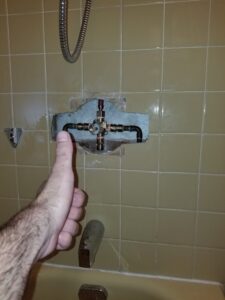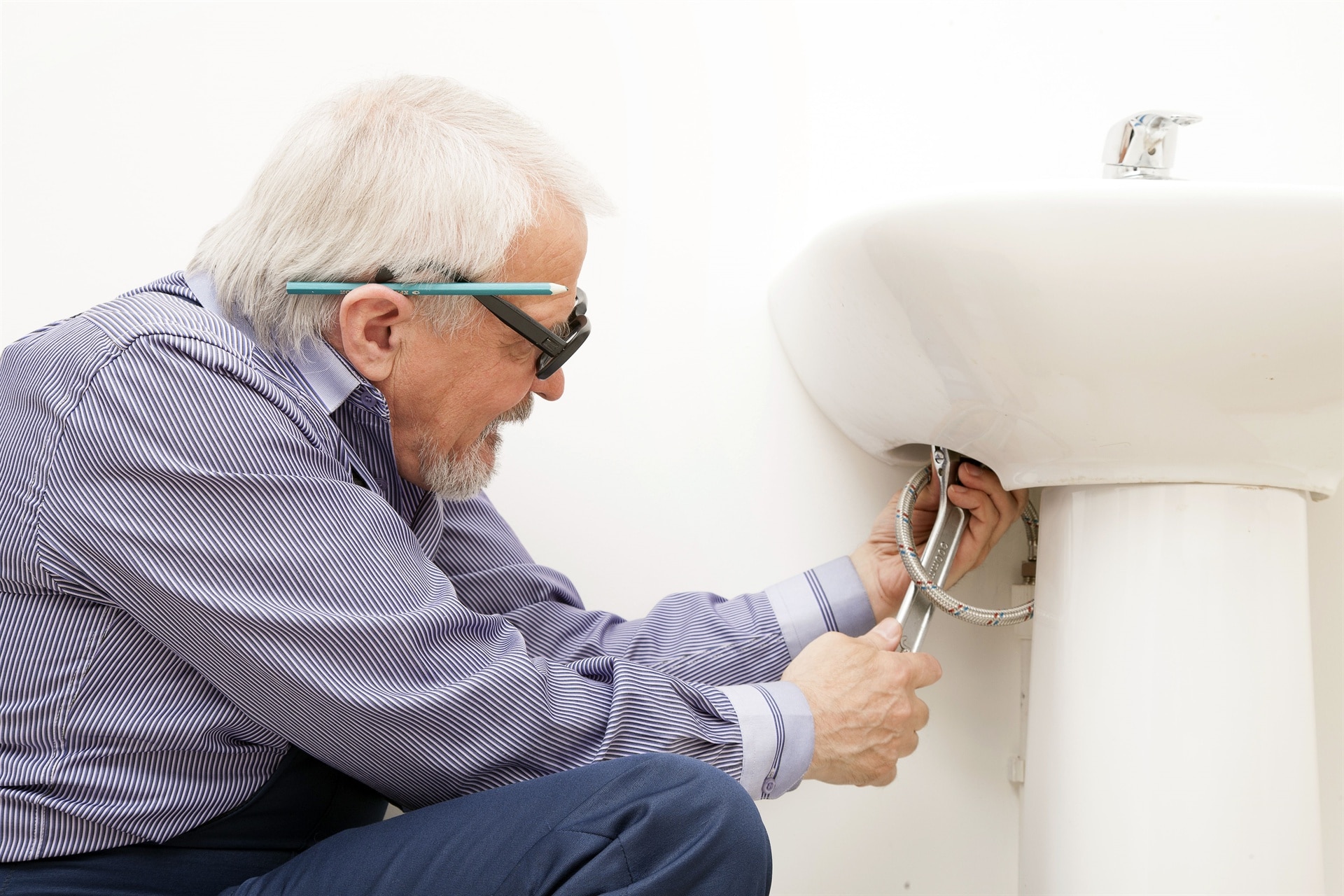
Wrench It Up > Services > Plumbing Service Installation And Repair > Toilet services > Toilet shut-off valve replacement


If you have ever wondered what that funny looking valve is next to your toilet, wonder no more! That valve is called a shut-off valve, and it is an important part of your plumbing.
The shut-off valve is there to allow you to turn off the water supply to your toilet without having to turn off the entire house’s water supply. This comes in handy if you need to make a repair to your toilet or if there is a leak.
To turn off the water supply, simply turn the knob or lever on the shut-off valve clockwise until it is in the “off” position. To turn the water back on, simply turn the knob or lever counter-clockwise.
Often overlooked, the shut-off valve behind your toilet plays a crucial role in the overall functionality of your bathroom. It controls the water supply to your toilet, and when it malfunctions, it can lead to leaks, water wastage, and even water damage. Our toilet shut-off valve replacement service aims to address these issues and bring a renewed efficiency to your bathroom.
Before delving into the replacement process, let’s identify the signs that your toilet shut-off valve might be crying out for help. Common indications include persistent leaks, difficulty in turning the valve, and visible corrosion. If you have noticed any of these issues, it is time to consider our specialized service.
Our skilled technicians follow a meticulous process when it comes to replacing your toilet shut-off valve. First, we conduct a thorough inspection to confirm the need for replacement. Once confirmed, we proceed to turn off the water supply, drain the existing water, and carefully remove the old valve. The new shut-off valve is then securely installed, ensuring a watertight seal.
Choosing the right plumbing service provider is crucial, especially when it comes to specialized services like toilet shut-off valve replacement. At Wrench It Up plumbing and mechanical, we bring not only technical expertise but also a commitment to customer satisfaction. Our team is trained to handle the intricacies of this replacement process with precision, ensuring that your bathroom is in safe hands.
While our replacement service is here to address issues, we also advocate for proactive measures to prevent problems in the first place. Regular maintenance, such as turning the shut-off valve on and off periodically, checking for leaks, and addressing any signs of wear and tear, can go a long way in extending the life of your toilet shut-off valve.
If your home is equipped with an older shut-off valve, replacing it presents an excellent opportunity to upgrade to a more modern and efficient model. The latest shut-off valves come with features like easy quarter-turn operation and enhanced durability, adding both convenience and longevity to your plumbing system.
At Wrench It Up plumbing and mechanical, we believe in transparent and fair pricing. Our toilet shut-off valve replacement service is designed to be not only effective but also affordable. We understand that plumbing needs should not break the bank, and our pricing reflects our commitment to providing cost-effective solutions.
Beyond technical expertise, we prioritize your experience with our service. From the moment you reach out to us to the completion of the replacement, our customer-centric approach ensures that you feel heard and valued. We aim not just to meet but to exceed your expectations.
In every service we offer, including toilet shut-off valve replacement, your satisfaction remains our top priority. We take pride in the quality of our work, the efficiency of our processes, and the smiles we bring to our customers’ faces. Trust Wrench It Up plumbing and mechanical to transform your bathroom with excellence and care.
If you have any questions about your shut-off valve or need help repairing your toilet, Wrench It Up plumbing and mechanical is here to help! Contact us before it is too late.
There are many reasons why a toilet shut-off valve may become faulty. The most common cause is simply wear and tear. Over time, the parts of the valve that are exposed to water and other elements will begin to degrade, causing the valve to become less effective. In some cases, the valve may even become completely blocked, preventing water from flowing through it.
Another common cause of toilet shut-off valve problems is improper installation. If the valve is not installed correctly, it can lead to a number of issues, including water leakage and poor water pressure. In some cases, the valve may even become completely detached from the piping, causing a complete loss of water flow.
If you suspect that your toilet shut-off valve is faulty, it is important to have it inspected by a professional as soon as possible. Toilet shut-off valve replacement is part of plumbing services provided by Wrench It Up plumbing and mechanical. Give us a call now!
If you are having trouble turning your shut-off valve, it is probably time to replace it.
Here is how to do it:
1. Locate the shut-off valve. It is usually located near the toilet, on the wall or floor.
2. Turn off the water to the toilet by turning the knob clockwise.
3. Flush the toilet to empty the tank and bowl.
4. Disconnect the water supply line from the shut-off valve. You may need a wrench to loosen the nut.
5. Remove the old shut-off valve by unscrewing it from the water pipe.
6. Install the new shut-off valve by screwing it onto the water pipe.
7. Reconnect the water supply line to the new shut-off valve.
8. Turn on the water to the toilet by turning the knob counterclockwise.
9. Test the new shut-off valve by flushing the toilet.
If you have any questions or need help with this project, Wrench It Up plumbing and mechanical is always here to help. Give us a call now!
There are a few different types of toilet shut-off valves, each with its own advantages and disadvantages. The best type of valve for your needs will depend on your particular situation.
One popular type of shut-off valve is the ball valve. This type of valve is typically very durable and easy to operate. However, ball valves can be more expensive than other types of valves, and they may not provide a completely watertight seal.
Another common type of shut-off valve is the gate valve. Gate valves are usually less expensive than ball valves, but they can be more difficult to operate. Gate valves also tend to create a more forceful water flow, which may be an advantage or disadvantage depending on your needs.
The shut-off valve on a toilet is typically found behind the toilet, near the floor. It is often a lever that you can pull up or down to stop the flow of water to the toilet.
The shut-off valve may also be located in another part of the bathroom, such as near the sink or in the basement. If you are not sure where your shut-off valve is, check with your local water company or contact Wrench It Up plumbing and mechanical for assistance.
No, they are not the same size. Toilet shut-off valves are typically ½ inch in diameter, while sink shut-off valves are typically ¾ inch in diameter. This is because larger water pipes are needed to supply water to sinks than to toilets.
It is possible to test a toilet shut-off valve to see if it is bad. One way to do this is to pour water into the toilet tank and then flush. If the water does not stop running after you flush, the shut-off valve is bad and needs to be replaced.
Another way to test a shut-off valve is to pour food coloring into the toilet tank and watch to see if it enters the bowl when you flush. If it does, that means there is a leak in your system and the shut-off valve is not stopping the flow of water. In either case, it is best to call Wrench It Up plumbing and mechanical to replace the bad shut-off valve.
To determine the size of your toilet shut-off valve, you need to know the company that manufactured your toilet. For most residential applications, a 1/2 inch valve is recommended. If you are unsure of the size of your shut-off valve, please consult Wrench It Up plumbing and mechanical.
There are three types of toilet shut-off valves: ballcock valve, float cup valve, and tank lever valve.
The ballcock valve is the most common type of toilet shut-off valve. It is activated when the water level in the tank falls below a certain level and opens to allow more water into the tank.
The float cup valve is a newer design that is more reliable than the ballcock valve. It is activated when the water level in the tank falls below a certain level and opens to allow more water into the tank.
The tank lever valve is activated when you lift up on the lever attached to the side of the tank. This opens a flap that allows more water to flow into the bowl from the tank.
Toilet shut-off valves generally last for 10 years. However, this lifespan can be shortened if the valve is not properly maintained. For example, if the valve is not kept free of sediment and mineral build-up, it will eventually clog and cease to function.
The specific answer to your question may vary depending on the brand or model of toilet you have, but in general, a shut-off valve should be replaced if it is leaking or if it becomes hard to turn.
There are other signs that your shut-off valve may need to be replaced, such as if water is constantly running from the tank even when the lever is in the "off" position.
It is possible that your shut-off valve is leaking because it needs to be replaced. Shut-off valves are one of the most commonly replaced plumbing fixtures in a home due to normal wear and tear. If your toilet shut-off valve is leaking, it is important to have it replaced as soon as possible to avoid any water damage.
Toilet shut-off valves come in a variety of sizes, and it is important to get the correct size for your toilet.



* By submission, you agree to receive email marketing from Wrench It Up plumbing and mechanical regarding our products and services.
If you are in need of an emergency plumbing service, please directly call us at 416-800-5050. We are 24/7 available throughout the year.